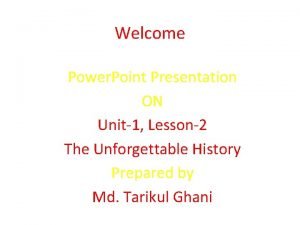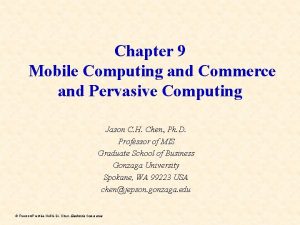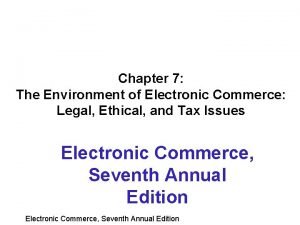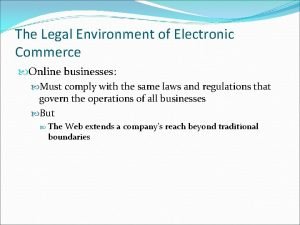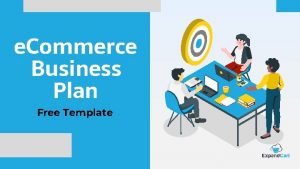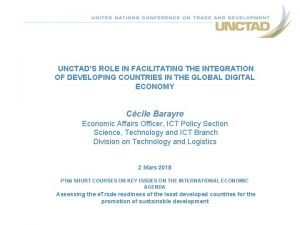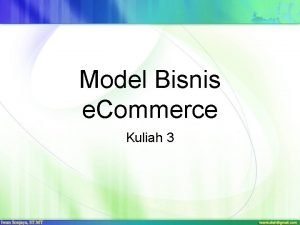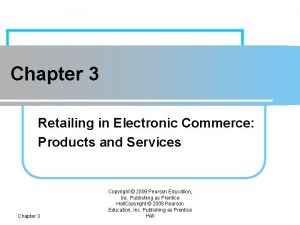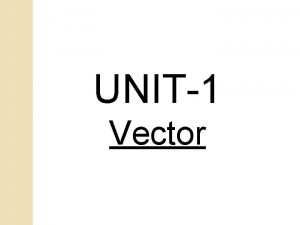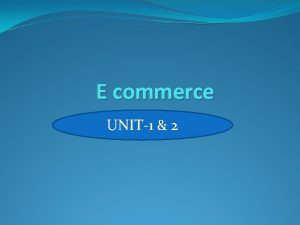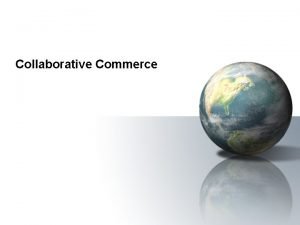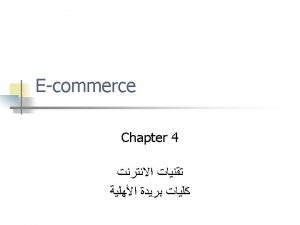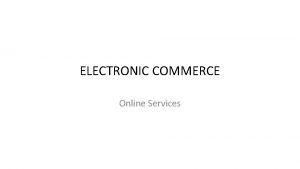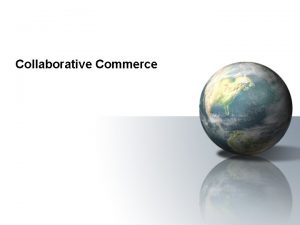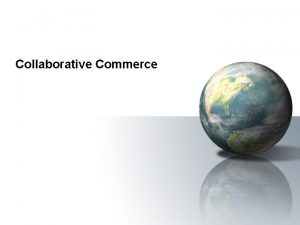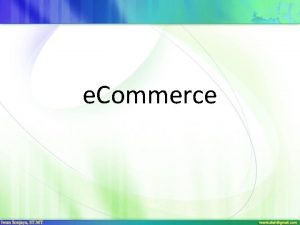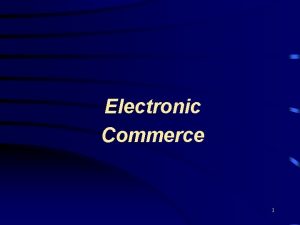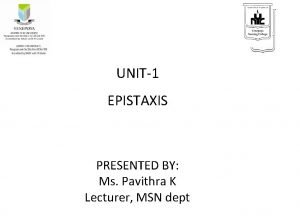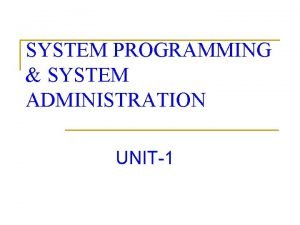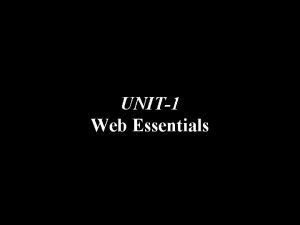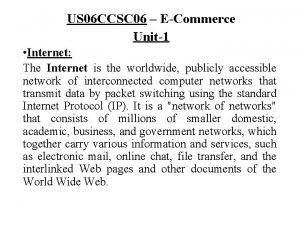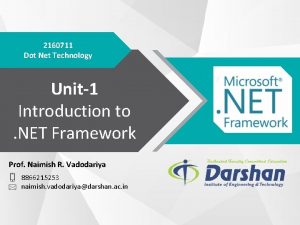E commerce UNIT1 2 E commerce is the




















































- Slides: 52

E commerce UNIT-1 & 2

�E commerce is the buying and selling of goods and services, over the electronic network like computer , smart phone or laptop etc. . called e commerce. � The concept of e commerce was first introduced in India in 1990 that raddif had been trying to capture the Indian market since the year 1999 and that IRCTC was the first company to create a successful e commerce portal

Types of E-Commerce �B 2 B e-commerce �B 2 C e-commerce �C 2 B e-commerce �C 2 C e-commerce

�B to B is a type of transaction that exist b/w business such as one involving the manufacturer and wholesaler (eg): Intel selling microprocessor to dell. � B to C is referred as business to consumer, describes the activities of business in selling products or services. (eg): Dell selling us a laptop. • C to C is enable consumer to sell directly to other consumers without having go through a middleman (eg) olx • C to B consumer posts his project with a set budget online and within hours companies review the consumer's requirements and bid on the project. The consumer reviews the bids and selects the company that will complete the project. • (eg) Elance

Key factors of e-commerce �Technology �Broad band internet �Smart device penetration �Availability of wider product range �Social status �E-commerce ecosystem �Customer satisfaction

Importance of E-commerce �E-commerce is popular because of its vast advantages. �It is very convenient for everyone to shop any time , anywhere and in any device I instead of visiting shops. �No need of physical company set- ups. �Buying /selling 24/7. �Better quality of service. �Ability to reach new market

Online market place �Flip cart was started by Sachin bansal and Binny Bansal in 2007. It is leading at the first position after acquire myntra in a deal of 3. 1 billion. �Snap deal was started by alumnus by IIT Delhi in 2010, it is placed at third position. �Myntra accuired fourth position, started in 2007 etc �On the other hand there are many other online web portal for online marketing.

Scope of e-commerce �India is completely growing stage of development , incredible India has a new name DIGITAL INDIA. �There is a huge scope of e-commerce , the current generation completely belongs to e service , which are most preferred ways to connect to people around the world. �Business website development. Advertizment

E-Commerce Transaction Processing �E-commerce transaction processing software: connects participants in the e-commerce economy and enables communication between trading partners, regardless of their technical infrastructure �Fully automates transaction processes from order placement to reconciliation �Web site traffic data analysis software: processes and analyzes data from the Web log file to provide useful information to improve Web site performance

Advantage and Disadvantage. E-commerce works properly • Unable to examine product easily �There is a possibility to credit card number theft. �Not everyone is connected to the internet. �Skills required

E-commerce Marketing and Advertising Copyright © 2015 Pearson Education, Inc.

Consumers Online: The Internet Audience and Consumer Behavior �Growth rate has slowed �Intensity and scope of use both increasing �Some demographic groups have much higher percentages of online usage than others �Income, education, age, ethnic dimensions

Consumers Online (cont. ) �Broadband mobile �Significant inequalities in broadband access �Older adults, lower income, lower educational levels �Non-broadband household still accesses Internet via mobile or other locations �Neighborhood effects �Role of social emulation in consumption decisions �“Connectedness” � Top 10– 15% are more independent � Middle 50% share more purchase patterns of friends �Recommender systems - co-purchase networks

Consumers Online (cont. ) �Study of consumer behavior �Social science discipline �Attempts to explain what consumers purchase and where, when, how much, and why they buy �Consumer behavior models Attempt to predict or explain wide range of consumer decisions � Based on background demographic factors and other intervening, more immediate variables � �Profiles of online consumers �Consumers shop online primarily for convenience

A General Model of Consumer Behavior Figure 6. 1, Page 375 SOURCE: Adapted from Kotler and Armstrong, 2009.

The Online Purchasing Decision �Five stages in consumer decision process �Awareness of need �Search for more information �Evaluation of alternatives �Actual purchase decision �Post-purchase contact with firm

The Consumer Decision Process and Supporting Communications Figure 6. 2, Page 376

The Online Purchasing Decision (cont. ) �Decision process similar for online and offline behavior �General online behavior model �User characteristics �Product characteristics �Web site features: latency, usability, security �Attitudes toward online purchasing �Perceptions about control over Web environment �Clickstream behavior

A Model of Online Consumer Behavior Figure 6. 3, Page 377

Shoppers: Browsers and Buyers �Shoppers: Almost 90% of Internet users � 74% buyers � 16% browsers (purchase offline) �One-third of offline retail purchases influenced by online activities �Online traffic also influenced by offline brands and shopping �E-commerce and traditional commerce are coupled: Part of a continuum of consuming behavior

What Consumers Shop for and Buy Online �Big ticket items �Travel, computer hardware, electronics �Consumers now more confident in purchasing costlier items �Small ticket items �Apparel, books, office supplies, software, and so on �Types of purchases depend on level of experience with the Web

How Consumers Shop �How shoppers find online vendors �Highly intentional, goal-oriented �Search engines �Marketplaces (Amazon, e. Bay) �Specific retail site � 10% of Internet users don’t shop online �Trust factor �Hassle factors (shipping costs, returns, etc. )

Trust, Utility, and Opportunism in Online Markets �Two most important factors shaping decision to purchase online: �Utility: � Better prices, convenience, speed �Trust: � Most important factors: Perception of credibility, ease of use, perceived risk � Sellers can develop trust by building strong reputations for honesty, fairness, delivery

Digital Commerce Marketing and Advertising: Strategies and Tools �Internet marketing (vs. traditional) �More personalized �More participatory �More peer-to-peer �More communal �The most effective Internet marketing has all four features

Multi-Channel Marketing Plan 1. Web site 2. Traditional online marketing � Search engine, display, e-mail, affiliate 3. Social marketing � Social networks, blogs, video, game 4. Mobile marketing � Mobile/tablet sites, apps 5. Offline marketing � Television, radio, newspapers

Strategic Issues and Questions �Which part of the marketing plan should you focus on first? �How do you integrate the different platforms for a coherent message? �How do you allocate resources? �How do you measure and compare metrics from different platforms? �How do you link each to sales revenues?

Establishing the Customer Relationship �Web site functions to: �Establish brand identity and customer expectations � Differentiating product �Anchor the brand online � Central point for all marketing messages �Inform and educate customer �Shape customer experience

Online Advertising �Online advertising �Display, search, mobile messaging, sponsorships, classifieds, lead generation, e-mail �Fastest growing form of advertising �Advantages: � 18– 34 audience is online � Ad targeting � Price discrimination � Personalization

Traditional Online Marketing and Advertising Tools �Search engine marketing and advertising �Display ad marketing �E-mail marketing �Affiliate marketing �Viral marketing �Lead generation marketing

Search Engine Marketing and Advertising �Search engine marketing (SEM) �Use of search engines for branding �Search engine advertising �Use of search engines to support direct sales �Types of search engine advertising �Sponsored links (keyword paid inclusion) �Keyword advertising �Network keyword advertising (context advertising)

Search Engine Marketing (cont. ) �Search engine optimization (SEO) �Google search engine algorithms �Panda, Penguin, Hummingbird, Knowledge Graph �Social search �Utilizes social contacts and social graph to provide fewer and more relevant results �Search engine issues �Paid inclusion and placement practices �Link farms, content farms �Click fraud

Display Ad Marketing �Banner ads �Rich media ads �Interstitial ads �Video ads �Far more effective than other display formats �Sponsorships �Native advertising

Display Ad Marketing (cont. ) �Advertising networks �Programmatic advertising �Real-time bidding process (RTB) �Ad exchanges �Display advertising issues �Ad fraud �Viewability

How an Advertising Network Such as Double. Click Works Figure 6. 7, Page 395

E-mail Marketing �Direct e-mail marketing �Messages sent directly to interested users �Benefits include � Inexpensive � Average over 6% click-throughs for in-house lists � Measuring and tracking responses � Personalization of messages and offers �Three main challenges �Spam �Anti-spam software �Poorly targeted purchased e-mail lists

Spam �Unsolicited commercial e-mail �Around 60% of all e-mail in 2014 �Most originates from bot networks �Efforts to control spam have largely failed: �Government regulation (CAN-SPAM) �State laws �Voluntary self-regulation by industries (DMA ) �Canada’s stringent anti-spam laws

Other Types of Traditional Online Marketing n Affiliate marketing v Commission fee paid to other Web sites for sending customers to their Web site n Viral marketing v Marketing designed to inspire customers to pass message to others n Lead generation marketing v Services and tools for collecting, managing, and converting leads

Social, Mobile, and Local Marketing and Advertising �Social marketing/advertising �Fastest growing type of online marketing �Enormous audiences of social networks �Four features driving growth � Social sign-on � Collaborative shopping � Network notification � Social search (recommendation)

Social Marketing/Advertising (cont. ) �Blog marketing �Educated, higher-income audience �Ideal platform to start viral campaign �Game marketing �Large audiences for social and mobile games �Used for branding and driving customers to purchase moments at restaurants and retail stores

Mobile Marketing and Advertising �The online marketing, growing rapidly �Major formats: �Display, rich media, video �Games �E-mail �Text messaging (SMS) �In-store messaging �Quick Response (QR) codes �Couponing �App marketing

Local Marketing �Geared to user’s geographic location �Most common local marketing tools �Geotargeting with Google Maps �Display ads in hyperlocal publications �Daily deals �Coupons

Multi-Channel Marketing �Consumers also multitask, using several media �Internet campaigns strengthened by using other channels �Most effective are campaigns using consistent imagery throughout channels

Other Online Marketing Strategies �Several strategies are more focused than traditional online and newer strategies �Customer retention strategies �Pricing strategies

Other Online Marketing Strategies �Customer retention strategies �Personalization and one-to-one marketing (interest-based advertising) � Retargeting � Behavioral � Based targeting on data from search engine queries, clickstream history, social network data, and integration of offline personal data and records � Effectiveness still inconclusive � Privacy issues

Other Online Marketing Strategies (cont. ) �Customization �Changing the product �Information goods ideal for differentiation �Customer co-production �Customers help create product �Customer service �FAQs �Real-time customer chat systems �Automated response systems

Pricing Strategies �Pricing �Integral part of marketing strategy �Traditionally pricing based on � Fixed cost � Variable costs � Demand curve �Price discrimination �Selling products to different people and groups based on willingness to pay

Pricing Strategies (cont. ) �Free and freemium � Can be used to build market awareness �Versioning � Creating multiple versions of product and selling essentially same product to different market segments at different prices �Bundling � Offers consumers two or more goods for one price �Dynamic pricing � Auctions � Yield management: Amazon � Surge pricing: Uber � Flash marketing: Rue La La, Haute. Look, Gilt Groupe

Internet Marketing Technologies �Internet’s main impacts on marketing: �Scope of marketing communications broadened �Richness of marketing communications increased �Information intensity of marketplace expanded �Always-on mobile environment expands marketing opportunities

Web Transaction Logs �Built into Web server software �Record user activity at Web site �Provides much marketing data, especially combined with: �Registration forms �Shopping cart database �Answers questions such as: �What are major patterns of interest and purchase? �After home page, where do users go first? Second?

Tracking Files �Users’ browsing tracked as they move from site to site �Four types of tracking files �Cookies � Small text file placed by Web site � Allows Web marketers to gather data �Flash cookies �Beacons (“bugs”) �Apps

Databases �Enable profiling �Store records and attributes �Database management system (DBMS): � Software used to create, maintain, and access databases �SQL (Structured Query Language): � Industry-standard database query and manipulation language used in a relational database �Relational database: � Represents data as two-dimensional tables with records organized in rows and attributes in columns; data within different tables can be flexibly related as long as the tables share a common data element

Data Warehouses and Data Mining �Data warehouse: �Collects firm’s transactional and customer data in single location for offline analysis by marketers and site managers �Data mining: �Analytical techniques to find patterns in data, model behavior of customers, develop customer profiles
 Slidetodoc.com
Slidetodoc.com Location-based commerce (l-commerce)
Location-based commerce (l-commerce) Thiếu nhi thế giới liên hoan
Thiếu nhi thế giới liên hoan Phối cảnh
Phối cảnh Bài hát chúa yêu trần thế alleluia
Bài hát chúa yêu trần thế alleluia điện thế nghỉ
điện thế nghỉ Một số thể thơ truyền thống
Một số thể thơ truyền thống Sơ đồ cơ thể người
Sơ đồ cơ thể người Công thức tiính động năng
Công thức tiính động năng Số nguyên tố là gì
Số nguyên tố là gì Tỉ lệ cơ thể trẻ em
Tỉ lệ cơ thể trẻ em đặc điểm cơ thể của người tối cổ
đặc điểm cơ thể của người tối cổ Các châu lục và đại dương trên thế giới
Các châu lục và đại dương trên thế giới ưu thế lai là gì
ưu thế lai là gì Thẻ vin
Thẻ vin Kể tên các môn thể thao
Kể tên các môn thể thao Tư thế ngồi viết
Tư thế ngồi viết Cái miệng nó xinh thế chỉ nói điều hay thôi
Cái miệng nó xinh thế chỉ nói điều hay thôi Hình ảnh bộ gõ cơ thể búng tay
Hình ảnh bộ gõ cơ thể búng tay Từ ngữ thể hiện lòng nhân hậu
Từ ngữ thể hiện lòng nhân hậu Trời xanh đây là của chúng ta thể thơ
Trời xanh đây là của chúng ta thể thơ Tư thế ngồi viết
Tư thế ngồi viết Chó sói
Chó sói Ví dụ giọng cùng tên
Ví dụ giọng cùng tên Thơ thất ngôn tứ tuyệt đường luật
Thơ thất ngôn tứ tuyệt đường luật Khi nào hổ con có thể sống độc lập
Khi nào hổ con có thể sống độc lập đại từ thay thế
đại từ thay thế Thế nào là hệ số cao nhất
Thế nào là hệ số cao nhất Diễn thế sinh thái là
Diễn thế sinh thái là Vẽ hình chiếu vuông góc của vật thể sau
Vẽ hình chiếu vuông góc của vật thể sau Frameset trong html5
Frameset trong html5 Làm thế nào để 102-1=99
Làm thế nào để 102-1=99 Thế nào là mạng điện lắp đặt kiểu nổi
Thế nào là mạng điện lắp đặt kiểu nổi Mật thư tọa độ 5x5
Mật thư tọa độ 5x5 Lời thề hippocrates
Lời thề hippocrates Vẽ hình chiếu đứng bằng cạnh của vật thể
Vẽ hình chiếu đứng bằng cạnh của vật thể Tư thế worm breton
Tư thế worm breton Quá trình desamine hóa có thể tạo ra
Quá trình desamine hóa có thể tạo ra Sự nuôi và dạy con của hươu
Sự nuôi và dạy con của hươu Dot
Dot Các châu lục và đại dương trên thế giới
Các châu lục và đại dương trên thế giới Bổ thể
Bổ thể Nguyên nhân của sự mỏi cơ sinh 8
Nguyên nhân của sự mỏi cơ sinh 8 độ dài liên kết
độ dài liên kết Legal environment in e commerce
Legal environment in e commerce Legal environment of e commerce
Legal environment of e commerce Eurostat e commerce statistics
Eurostat e commerce statistics Enterprise-class electronic commerce software:
Enterprise-class electronic commerce software: Ecommerce business plan excel
Ecommerce business plan excel Ecommerce software and hardware
Ecommerce software and hardware Three pillars of e commerce
Three pillars of e commerce Model bisnis e-commerce
Model bisnis e-commerce Retailing in electronic commerce products and services
Retailing in electronic commerce products and services
